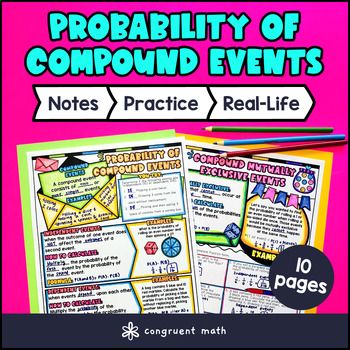Want more ideas and freebies?
Get my free resource library with digital & print activities—plus tips over email.
Join for Free Resources →
$4.25
Ever wondered how to teach probability of compound events in an engaging way to your 7th-grade students? In this lesson plan, students will learn about finding probabilities of compound events, including independent, dependent, and mutually exclusive events. Through artistic, interactive guided notes, check for understanding activities, a doodle & color by number worksheet, and a maze worksheet, students will gain a comprehensive understanding of probability of compound events. The lesson ends with a real-life example that explores the real-life applications of this math skill.

$4.25
After this lesson, students will be able to:
Before this lesson, students should be familiar with:
As a hook, ask students why understanding the probability of compound events is important in real life. You can provide examples such as determining the likelihood of winning a raffle with multiple prizes, predicting the chances of getting heads or tails when flipping multiple coins, or calculating the probability of drawing certain cards from a deck during a card game. Refer to the last page of the guided notes for additional ideas.
Use the first two pages of the guided notes to introduce the topic of compound events and provide an overview of the different types of events: independent events, dependent events, and mutually exclusive events. Walk through the concept of sample space and how it helps us determine the total number of possible outcomes in a given situation. Emphasize the importance of organizing the outcomes using lists, tree diagrams, or the fundamental counting principle. Refer to the FAQs below for a walkthrough on this, as well as ideas on how to respond to common student questions.
Based on student responses during the discussion, identify any areas where students may need additional clarification or examples. If necessary, reteach and provide more practice on specific concepts to ensure a solid foundation. If your class has a wide range of proficiency levels, you can pull out students for reteaching while more advanced students begin working on the practice exercises.
Have students practice finding probabilities of compound events using the practice coloring worksheet included in the resource. Walk around the classroom to answer any student questions and provide any necessary support or clarification.
Fast finishers can then move on to the maze activity provided in the resource for extra practice. You can assign it as homework for the remainder of the class.
Bring the class back together, and introduce the concept of real-life applications of finding probabilities of compound events. Explain that understanding probability is not only important in math class, but also in real-world situations.
Some examples of real-life applications include:
Encourage students to think of their own examples of real-life situations where probabilities are used. This will help them understand the practical application of the concept and its relevance in their everyday lives.
Refer to the FAQ section for more ideas on how to teach real-life applications of finding probabilities of compound events.
If you're looking for digital practice for Probability of Compound Events, try my Pixel Art activities in Google Sheets. Every answer is automatically checked, and correct answers unlock parts of a mystery picture. It's incredibly fun, and a powerful tool for differentiation.
Here are 2 activities to explore:
A fun, no-prep way to practice Probability of Compound Events is Doodle Math — they're a fresh take on color by number or color by code. It includes multiple levels of practice, perfect for a review day or sub plan.
Here are 2 activities to try:
Independent events are events where the outcome of one event does not affect the outcome of the other event. Dependent events, on the other hand, are events where the outcome of one event does affect the outcome of the other event.
Independent events:
Dependent events:
A sample space in probability refers to the set of all possible outcomes of an experiment or event. It includes every possible outcome that can occur.
To calculate the probability of compound events, you need to consider whether the events are independent or dependent.
For independent events:
For dependent events:
The fundamental counting principle is a method used to determine the total number of outcomes in a sequence of events. It states that if there are "m" ways of doing one thing and "n" ways of doing another thing, then there are "m x n" ways of doing both things together.
A tree diagram is a graphical representation that helps visualize the different outcomes and probabilities of compound events. To use a tree diagram:
Mutually exclusive events are events that cannot occur at the same time. If one event happens, the other event cannot happen simultaneously.
To determine if two events are mutually exclusive, you need to check if they share any common outcomes. If there are no common outcomes between the two events, then they are mutually exclusive.
Sure! One example of a real-life application of compound events is weather forecasting. In weather forecasting, meteorologists use information from different weather models to predict the probability of both rain and wind occurring on a specific day. By considering the probabilities of independent or dependent events (such as the chance of rain and wind occurring together), meteorologists can provide more accurate forecasts to the public.
Get my free resource library with digital & print activities—plus tips over email.
Join for Free Resources →